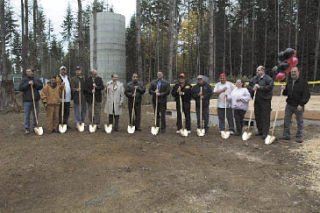TULALIP — Tribal, county and federal representatives were on hand to grab shovels and cheer on the first five families to take part in the first U.S. Department of Agriculture self-help housing program to break ground on tribal lands in the United States.
The Tulalip Tribes have dedicated five lots on their reservation to Housing Hope’s self-help housing program, with the option to add lots in the future, and the two organizations jointly staged a groundbreaking ceremony Oct. 30 at the Tribes’ Mission Highlands site.
Tulalip Tribal Chairman Mel Sheldon touted the historic nature of the occasion, while expressing the Tribes’ intention to expand the housing program for more of their members. As the event’s master of ceremonies, he introduced Tribal members who performed songs of paddling, to signify the owner-builders’ harmonious efforts toward a common destination, and of cleansing, to signify the fresh start that these houses will help provide their owner-builders.
Tulalip Tribal Board member Glen Gobin noted the distinction between a home that one purchases and a home that one builds through “sweat equity,” as with Housing Hope’s programs, and deemed the builders’ work on these homes to be indicative of “true ownership.”
“Our hands go up to you,” Tulalip Tribal Vice Chairwoman Marie Zackuse said to the Housing Hope, Tribal and federal representatives who helped make the program possible.
With 42 years under his belt, Stan Jones is the longest-serving Tulalip Tribal Board member and he reflected on the progress that the Tribes have made during his lifetime.
“We have 4,000-5,000 jobs now,” Jones said. “I can remember when we had three. Back in the Great Depression, we got contaminated food from the government. I’m so proud of how far we’ve come, that we’ve built this far.”
With only a year of service so far, Tony Hatch is the most recently elected Tulalip Tribal Board member and he expressed pride in being able to be part of this historic moment.
“This is an exciting time for a lot of families,” Hatch said. “It means that much more when you can give a part of yourself to your home. These people aren’t afraid to get their hands dirty for what they believe in. The work ethic here is amazing.”
Housing Hope Executive Director Ed Petersen explained that his organization’s goal is to help build both houses and communities, by giving prospective owner-builders “a hand up, not a hand-out.” The owner-builders began their work Oct. 4, and to foster a sense of community between them, they’re required to work on each other’s houses. They have literally thousands of hours of hard labor ahead of them and no one will be allowed to move in until everyone’s houses are completed. Petersen added that the experience would teach the owner-builders practical manual skills, as well as lessons in conflict management.
“You’ll be accountable for your own futures, but you’ll also be depending on everyone else,” Peterson said.
Former Tulalip Tribal Board member Herman Williams Jr. promised to join in the building effort.
“I won’t mind washing the mud off my heels,” Williams said. “I’ll be here, standing up walls and putting in nails. I’m excited to get black fingernails.”
Wes Cochran, an area specialist with the USDA’s Rural Development, pointed out that the USDA’s long-standing role in administration of farmers’ homes has made it the leader in economic and infrastructure development for housing in rural areas. He congratulated the Tribes and Housing Hope for setting this historic precedent which he believes could serve as a template for future self-help housing programs on tribal lands.
“You should pat yourselves on the back,” said Cochran, who also praised Native American tribes as a whole for their multigenerational commitment to environmental stewardship. “You took the ball and ran with it.”
Snohomish County Executive Aaron Reardon joined the chorus of voices commending both the Tribes and Housing Hope as he recalled how “the Tulalip reservation looks quite a bit different from when I was a young man.” He acknowledged the difficulties of the current economy, but he also held up the Tribes as an example of how a community can prosper when it’s given opportunity and investment.
“This is not a safety net,” Reardon said. “It’s a trampoline.”
Of the Mission Highlands site’s five families, two of them — Rebecca and William Hunter, and Jennifer and Kevin Johnson — were unable to attend the groundbreaking ceremony, but the rest — Marvin Jones, Anna and Gene Wysocki, and Shelley and James “Snooks” Yant — were all present to turn the earth with their ceremonial golden shovels. The Yants quickly gave way to tears after they were called up to speak, but both they and the Wysockis were more composed later on, as they anticipated as many as nine months of construction work ahead of them.
Both families are employed by the Tulalip Casino, which gave them the day off, and for both the Wysockis and the Yants, these homes will be the first that they can call their own, since all of their previous residences have been rentals. They both look forward to decorating, renovating and landscaping their homes and yards as they see fit, without having to ask for permission.



